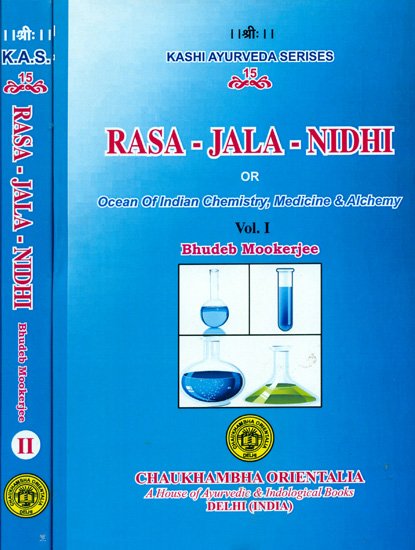Rasa Jala Nidhi, vol 3: Metals, Gems and other substances
by Bhudeb Mookerjee | 1938 | 47,185 words | ISBN-10: 8170305829 | ISBN-13: 9788170305828
This third volume of the Rasa-jala-nidhi deals with purification techniques of the Seven Metals (sapta-dhatu) and various Gems (ratna). It also deals with substances such as Alkalis (kshara), Salts (lavana), Poisions (visha) and Semi-poisions (upavisha) as well as various alcholic liquors. The Rasa-jala-nidhi (“the ocean of Iatrochemistry, or, che...
Part 1 - Characteristics of Topaz (pushparaga)
Pushparaga (topaz) can be obtained in two different kinds of mines, viz. in mines of ruby and in those of emeralds. Pushparaga, according to king Chandra Sena, the chemist,[1] is yellowish, transparent, and bright like a diamond. It brings son and wealth to its wearer.
Distinction of pusparaga from the other gems.
The stone which is yellowish-pale and bright is called “pusparaga”. It is called “kaurantaka”, if it is yellowish-red in colour. It is called “kashaya”, if it is reddish-yellow and transparent. It is “somalaka”, if it is bluish white and smooth. The stone which is very red is a ruby, and that which is deep-blue is a sapphire.
Sub-colours of Topazes.
They are (1) white, (2) yellow, (3) pale-white, and (4) black.
Characteristics of good Topaz.
A good topaz is heavy, transparent, appearing to have its surface smeared with an oily substance, thick, well-shaped, soft, having the colour of a karnikara flower, and smooth.
Characteristics of a bad Topaz.
(a) A defective topaz has got black spots on its surface, is rough, white, devoid of lustre, light, devoid of a sub-colour, and has sugar-like spots.
(b) A bad topaz is devoid of lustre; it is coarse, rough, yellow, black, having an undulating surface, brown or reddish brown, tawny, and pale-white.
Properties of pushpa-raga.
Pushpa-raga is efficacious in poison, nausea, excess of phlegm and vayu, loss of digestive power, inflammation, leprosy, and hemorrhage. It is easy to digest.
Footnotes and references:
[1]:
For a brief history of Indian Chemistry, see Chapter III, page 46 of the author’s book entitled “Indian Civilization and its Antiquity.”—(Price Rs. 2. India).
Conclusion:
 This concludes ‘Characteristics of Topaz (pushparaga)’ included in Bhudeb Mookerjee Rasa Jala Nidhi, vol 3: Initiation, Mercury and Laboratory. The text includes treatments, recipes and remedies and is categorised as Rasa Shastra: an important branch of Ayurveda that specialises in medicinal/ herbal chemistry, alchemy and mineralogy, for the purpose of prolonging and preserving life.
This concludes ‘Characteristics of Topaz (pushparaga)’ included in Bhudeb Mookerjee Rasa Jala Nidhi, vol 3: Initiation, Mercury and Laboratory. The text includes treatments, recipes and remedies and is categorised as Rasa Shastra: an important branch of Ayurveda that specialises in medicinal/ herbal chemistry, alchemy and mineralogy, for the purpose of prolonging and preserving life.
